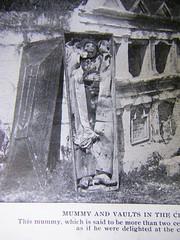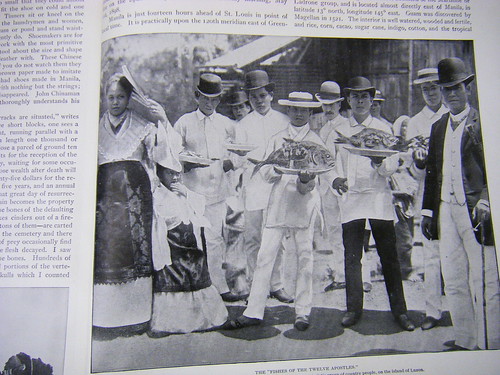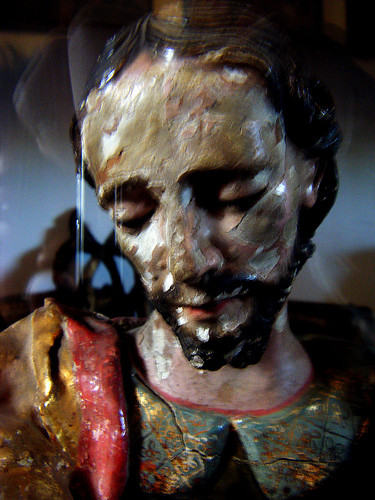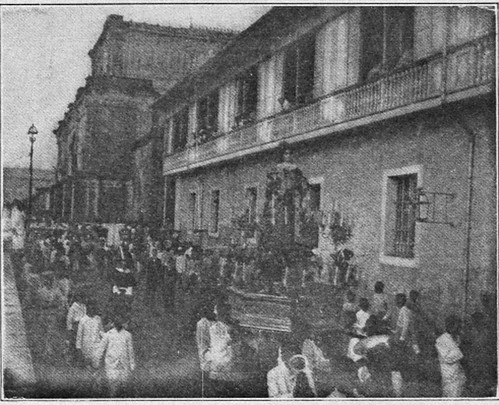Quite an absurd thought but funny how some way of thinking never changes.
Here's a very interesting chapter from Walter Robb's 1935,
Romance and Adventure in Old Manila originally from a manuscript by Percy Hill.

Ysidro Paulino
First half of the 1800's.
XVII
A QUESTION OF THEOLOGYIn the year 1693 a trading goleta of the flag of Spain
picked up a shipwrecked boat near the town of Binangonan de Lampon.
In the boat was the decaying body of a man, and two Spaniards barely fit to be termed alive.
They were reduced to the last extremity, and proved to be the
only survivors of the crew of the Santo Cristo de Burgos, which,
having sailed from Cavite some months before, had foundered
at sea near the Marianas Islands. One of the unfortunates
had lost his reason: he became an object of charity at the San
Juan de Dios Hospital in the walled city of Manila. Here he
so constantly raved about eating human flesh that suspicion
finally fell upon his companion, who was arrested and put to
the confession.
He was a common sailor, his name was Juan Valencia. He
stated to the authorities that after the galleon had foundered,
he and five companions put off in a boat. Though it was poorly provisioned, they decided to put back to the Philippines; and
placing their trust in God and the Virgin of Antipolo, they used
both oars and sail. After three weeks their scanty provisions
gave out; but their small stock of fresh water was added to by
passing squalls; they caught the rain by means of an old sail.
The dead calms were the most difficult to withstand. Their
tiny craft tossed upon sickening swells between sea and sky.
But these swells occasionally supplied them with a few flying
fish, and once a huge sea turtle.
Day after day they voyaged over the illimitable ocean, looking in vain for a landfall. Literally starving, at last two of
their number slipped quietly overboard, in despair of ever seeing
land again. The remaining four ate their jackboots and belts to still the gnawings of hunger and stay the hand of death.
Finally it was decided to draw lots: one might die that the
others might live. Choice fell upon the youngest of all. After
he had confessed and made his orisons, he bravely submitted
to the knife and his body was divided by lot among the other
three.
In spite of this heroic sacrifice, one of the three, who
could not partake of such gruesome food, died of starvation. A
few days later the two remaining of the six who had put off
from the foundered galleon were picked up by the goleta and
brought to Manila.
Such was the sailor’s story.
The authorities, however, were not convinced that Valencia
was not a self-confessed criminal. They believed he should be
punished for cannibalism, although his statement was no more
unlikely than many a truthful account of those days, of men
who went down to the sea in ships. The ecclesiastics also
claimed that he was guilty of destroying a human soul, if not
actually partaking of it. He was therefore kept a prisoner
until his fate should be decided.
Governor Gongora was glad to refer this knotty problem
to the clergy, who claimed jurisdiction because of the destruction
of a soul.
The unhappy mariner was brought before them. He made
a favorable impression by his manly attitude and Catholic demeanor, even more than by the distressing circumstances in
which he found himself. But the argument of the sympathetic
though learned theologians rested on the fact that the eating of
a human body meant inevitably the destruction of a human soul.
Valencia repeated that he had only eaten the flesh to preserve
his life, and that the victim was resigned by lot. Asked what
portion of the body he had eaten, he replied that the feet had
fallen to his share. The question then arose, in what part of
the body did the soul dwell?
This was argued pro and con by the assembled divines.
The majority maintained that the soul occupied the whole body,
but the prior of the Franciscans wisely observed that if a good
man suffered the loss of an arm, it might go to paradise; and
if later he was so unfortunate as to die in mortal sin, the rest
of his body-might go to hades-which was too absurd to be allowed..
Finally it was arranged that the Faculty should consider
the theorem: Does the soul extend to the extremities; if not,
just where does it terminate?
The arguments in the ease were so prolonged and technically involved that the theologians were much perplexed, and at
last divided into two camps. They were in doubt as to
whether they should hang, by their honest decision, a good
Catholic, or canonize a reprobate and a cannibal. The pros
and cons, the ayes and nays, kept the monasteries in constant
tumult. Pronouncements buried in dusty tomes, precedents at
great length and wordy wranglings of medieval thought, promised to draw the matter out indefinitely.
Meantime the mariner preserved a righteous demeanor and awaited the outcome
with placid content. He did not, however, neglect the good
food provided him by the monastery cook, who determined that
as far as lay in his humble power the prisoner should have no
second pretext to commit cannibalism.
At length the weighty decision was handed down, by a
picked jury of the most learned. They agreed in the verdict
that the soul of man extends only to the knees: man is required
to kneel in prayer; ergo, that portion of the body that extends
below the knees is a soulless appendage. The indictment against
Valencia was accordingly stricken out. He was allowed to go
free, but as long as he remained in Manila he was the object of
curiosity as a Christian fortunate enough to have warded away
starvation at sea with the part of the body which had nothing
to do with the soul.
~
Romance and Adventure in Old Manila
Walter Robb
2nd edition, 1935
P.183-185










